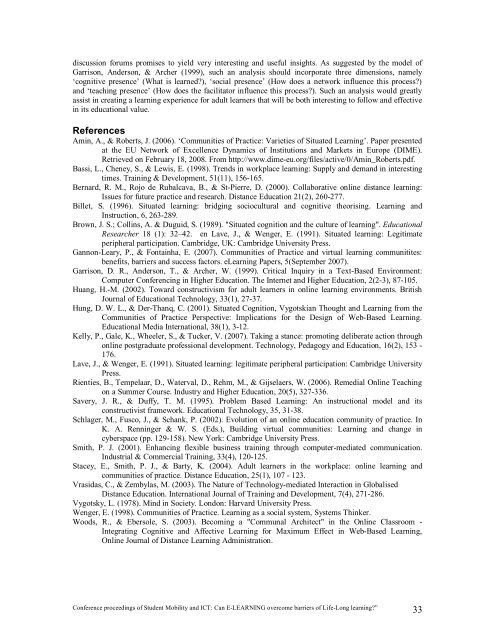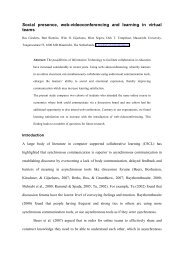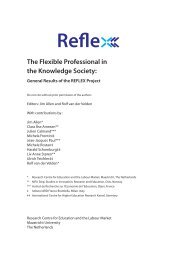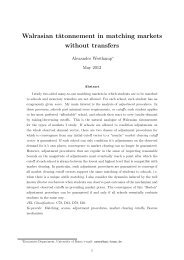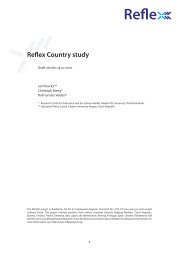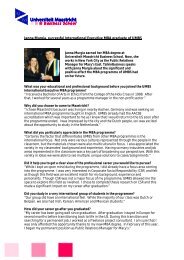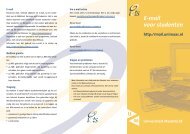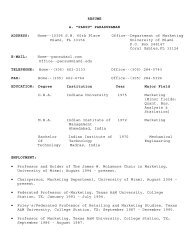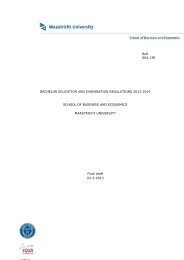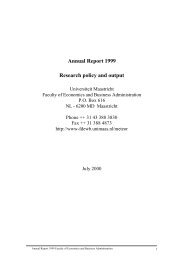proceedings of Student Mobility and ICT: Can E-LEARNING
proceedings of Student Mobility and ICT: Can E-LEARNING
proceedings of Student Mobility and ICT: Can E-LEARNING
You also want an ePaper? Increase the reach of your titles
YUMPU automatically turns print PDFs into web optimized ePapers that Google loves.
discussion forums promises to yield very interesting <strong>and</strong> useful insights. As suggested by the model <strong>of</strong><br />
Garrison, Anderson, & Archer (1999), such an analysis should incorporate three dimensions, namely<br />
‘cognitive presence’ (What is learned?), ‘social presence’ (How does a network influence this process?)<br />
<strong>and</strong> ‘teaching presence’ (How does the facilitator influence this process?). Such an analysis would greatly<br />
assist in creating a learning experience for adult learners that will be both interesting to follow <strong>and</strong> effective<br />
in its educational value.<br />
References<br />
Amin, A., & Roberts, J. (2006). ‘Communities <strong>of</strong> Practice: Varieties <strong>of</strong> Situated Learning’. Paper presented<br />
at the EU Network <strong>of</strong> Excellence Dynamics <strong>of</strong> Institutions <strong>and</strong> Markets in Europe (DIME).<br />
Retrieved on February 18, 2008. From http://www.dime-eu.org/files/active/0/Amin_Roberts.pdf.<br />
Bassi, L., Cheney, S., & Lewis, E. (1998). Trends in workplace learning: Supply <strong>and</strong> dem<strong>and</strong> in interesting<br />
times. Training & Development, 51(11), 156-165.<br />
Bernard, R. M., Rojo de Rubalcava, B., & St-Pierre, D. (2000). Collaborative online distance learning:<br />
Issues for future practice <strong>and</strong> research. Distance Education 21(2), 260-277.<br />
Billet, S. (1996). Situated learning: bridging sociocultural <strong>and</strong> cognitive theorising. Learning <strong>and</strong><br />
Instruction, 6, 263-289.<br />
Brown, J. S.; Collins, A. & Duguid, S. (1989). "Situated cognition <strong>and</strong> the culture <strong>of</strong> learning". Educational<br />
Researcher 18 (1): 32–42. en Lave, J., & Wenger, E. (1991). Situated learning: Legitimate<br />
peripheral participation. Cambridge, UK: Cambridge University Press.<br />
Gannon-Leary, P., & Fontainha, E. (2007). Communities <strong>of</strong> Practice <strong>and</strong> virtual learning communitites:<br />
benefits, barriers <strong>and</strong> success factors. eLearning Papers, 5(September 2007).<br />
Garrison, D. R., Anderson, T., & Archer, W. (1999). Critical Inquiry in a Text-Based Environment:<br />
Computer Conferencing in Higher Education. The Internet <strong>and</strong> Higher Education, 2(2-3), 87-105.<br />
Huang, H.-M. (2002). Toward constructivism for adult learners in online learning environments. British<br />
Journal <strong>of</strong> Educational Technology, 33(1), 27-37.<br />
Hung, D. W. L., & Der-Thanq, C. (2001). Situated Cognition, Vygotskian Thought <strong>and</strong> Learning from the<br />
Communities <strong>of</strong> Practice Perspective: Implications for the Design <strong>of</strong> Web-Based Learning.<br />
Educational Media International, 38(1), 3-12.<br />
Kelly, P., Gale, K., Wheeler, S., & Tucker, V. (2007). Taking a stance: promoting deliberate action through<br />
online postgraduate pr<strong>of</strong>essional development. Technology, Pedagogy <strong>and</strong> Education, 16(2), 153 -<br />
176.<br />
Lave, J., & Wenger, E. (1991). Situated learning: legitimate peripheral participation: Cambridge University<br />
Press.<br />
Rienties, B., Tempelaar, D., Waterval, D., Rehm, M., & Gijselaers, W. (2006). Remedial Online Teaching<br />
on a Summer Course. Industry <strong>and</strong> Higher Education, 20(5), 327-336.<br />
Savery, J. R., & Duffy, T. M. (1995). Problem Based Learning: An instructional model <strong>and</strong> its<br />
constructivist framework. Educational Technology, 35, 31-38.<br />
Schlager, M., Fusco, J., & Schank, P. (2002). Evolution <strong>of</strong> an online education community <strong>of</strong> practice. In<br />
K. A. Renninger & W. S. (Eds.), Building virtual communities: Learning <strong>and</strong> change in<br />
cyberspace (pp. 129-158). New York: Cambridge University Press.<br />
Smith, P. J. (2001). Enhancing flexible business training through computer-mediated communication.<br />
Industrial & Commercial Training, 33(4), 120-125.<br />
Stacey, E., Smith, P. J., & Barty, K. (2004). Adult learners in the workplace: online learning <strong>and</strong><br />
communities <strong>of</strong> practice. Distance Education, 25(1), 107 - 123.<br />
Vrasidas, C., & Zembylas, M. (2003). The Nature <strong>of</strong> Technology-mediated Interaction in Globalised<br />
Distance Education. International Journal <strong>of</strong> Training <strong>and</strong> Development, 7(4), 271-286.<br />
Vygotsky, L. (1978). Mind in Society. London: Harvard University Press.<br />
Wenger, E. (1998). Communities <strong>of</strong> Practice. Learning as a social system, Systems Thinker.<br />
Woods, R., & Ebersole, S. (2003). Becoming a "Communal Architect" in the Online Classroom -<br />
Integrating Cognitive <strong>and</strong> Affective Learning for Maximum Effect in Web-Based Learning,<br />
Online Journal <strong>of</strong> Distance Learning Administration.<br />
Conference <strong>proceedings</strong> <strong>of</strong> <strong>Student</strong> <strong>Mobility</strong> <strong>and</strong> <strong>ICT</strong>: <strong>Can</strong> E-<strong>LEARNING</strong> overcome barriers <strong>of</strong> Life-Long learning?” 33


